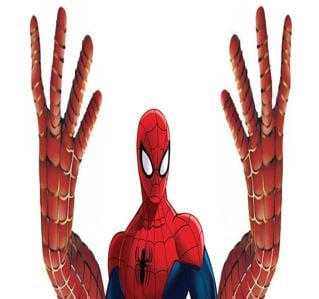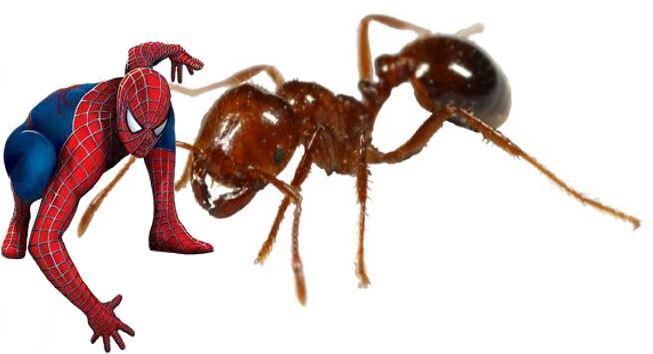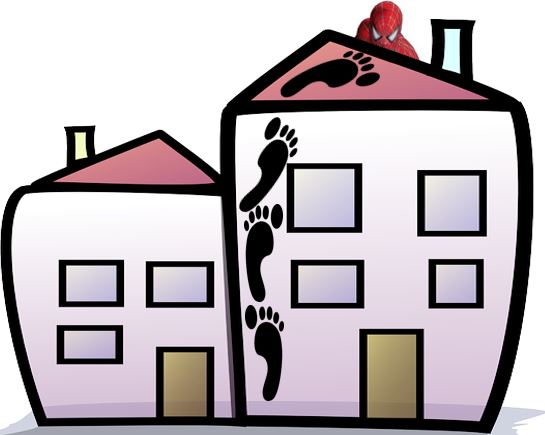Spiderman must have size 95 feet (114 in the US) if he really wants to climb walls like the superhero in the movies and comic books – plus his hands would need to be ultra-big too, says a team of British, American and Australian scientists.
If you want a Spiderman with normal proportions regarding hands and feet size, it is possible, but he would have to be super tiny, about the size of an ant. A human-size Spiderman who could climb smooth, vertical walls could only do so with feet that would make those of a clown look dainty, and abnormally large hands.
He would not look at all like Peter Parker, the high school student behind Spider-Man’s secret identity.
 To be able to scale vertical walls, Spiderman would be a bizarre-looking superhero. His hands would be bigger than in this picture, and his feet would be enormous.
To be able to scale vertical walls, Spiderman would be a bizarre-looking superhero. His hands would be bigger than in this picture, and his feet would be enormous.
Dr. David Labonte, from the Department of Zoology at the University of Cambridge in England, and colleagues say that for Spiderman to be able to scale vertical walls, he would need adhesive pads covering about 40% of his body’s surface, or 80% of the front of his body.
The research team, also included Christofer J Clemente (University of the Sunshine Coast, Australi), Alex Dittrich (Anglia Ruskin University, Cambridge, England), Chi-Yun Kuo (University of Massachusetts, USA), Alfred J Crosby (Engineering, University of Massachusetts Amherst, USA), Duncan J Irschick Engineering, University of Massachusetts Amherst, USA), and Walter Federle (University of Cambridge, England).
The team, who published their research and findings in the academic journal PNAS, said they found that geckos – lizards that live in warm climates across the world – are the largest animals on Earth with the ability to climb straight up smooth walls.
The scientists say their findings will be useful for makers of large-scale gecko-like adhesives.
Vertical climbers come in small and ultra-tiny sizes
Animals that can scale vertical walls vary in size from ultra-tiny mites to geckos, which compared to us are also small. Smaller creatures require a lower percentage of their body surface to be covered in sticky footpads, compared to larger animals.
In nature, the gecko is the limit – the largest – in body size for vertical wall climbing. Larger animals would need abnormally large hands (paws) and feet. Evolution would never permit creatures to develop in such a way, or have adhesive pads covering so much of the body.
An average-sized human being would need to have approximately 40% of his or her body surface covered in sticky pads (80% of their front), in order to do what the fictional Spiderman can do.
 If you want a Spiderman to climb walls and have normal-sized hands and feet in relation to the rest of the body, he would have to be the size of an ant.
If you want a Spiderman to climb walls and have normal-sized hands and feet in relation to the rest of the body, he would have to be the size of an ant.
A man with size 114 feet
Senior author, Dr. Walter Federle, University Reader in Comparative Biomechanics at Cambridge University’s Department of Zoology, explained:
“If a human, for example, wanted to climb up a wall the way a gecko does, we’d need impractically large sticky feet – and shoes in European size 145 or US size 114 (UK size 95).”
An animal’s body surface area per volume decreases the larger it is. For example, a flea has very little volume but lots of surface area, while a whale is mostly volume with very little surface area, the researchers explained.
Dr. Labonte said, regarding bigger climbing animals:
“This poses a problem for larger climbing animals because, when they are bigger and heavier, they need more sticking power, but they have comparatively less body surface available for sticky footpads.”
“This implies that there is a maximum size for animals climbing with sticky footpads – and that turns out to be about the size of a gecko.”
Dr. Labonte and colleagues compared the footpad sizes and body weights of 225 climbing animal species, including several types of insects, frogs, spiders, lizards, and even one mammal.
They covered a range of sizes, equivalent to the difference between Big Ben, the Great Bell of the clock at the north end of the Palace of Westminster in London, and a cockroach.
 Whenever giant footprints were seen up vertical walls, everybody would know that Spiderman had been there.
Whenever giant footprints were seen up vertical walls, everybody would know that Spiderman had been there.
Most sticky feet are similar
The team was surprised to find how similar the sticky feet of so many different animals were, despite their differences in size, lifestyles and species type.
Dr. Labonte highlighted this example of convergent evolution with the following comment:
“Adhesive pads of climbing animals are a prime example of convergent evolution – where multiple species have independently, through very different evolutionary histories, arrived at the same solution to a problem. When this happens, it’s a clear sign that it must be a very good solution.”
An alternative – stickier pads
An alternative to having larger and larger feet and hands for bigger animals, is to make each pad considerably stickier, an evolutionary path some tree frogs have experienced.
Co-author, Dr. Christofer Clemente, Lecturer in Animal Ecophysiology (the study of studies the adaptation of an organism’s physiology to environmental conditions) in the Faculty of Science Health Educaton and Engineering, part of The University of the Sunshine Coast, Australia, said:
“We noticed that within some groups of closely related species, pad size was not increasing fast enough to match body size yet these animals could still stick to walls.”
“We found that tree frogs have switched to this second option of making pads stickier rather than bigger. It’s remarkable that we see two different evolutionary solutions to the problem of getting big and sticking to walls.”
“Across all species the problem is solved by evolving relatively bigger pads, but this does not seem possible within closely related species, probably since the required morphological changes would be too large. Instead within these closely related groups, the pads get stickier in larger animals, but the underlying mechanisms are still unclear. This is a great example of evolutionary constraint and innovation.”
Commercial development of large-scale bio-inspired adhesives
The research team believes these insights into sticky footpad size limits will have profound implications for those involved in the development of large-scale bio-inspired adhesives, which today are only effective on very small areas.
Dr. Labonte explained:
“Our study emphasises the importance of scaling for animal adhesion, and scaling is also essential for improving the performance of adhesives over much larger areas.”
The study was supported by grants from the UK Biotechnology and Biological Sciences Research Council, the Human Frontier Science Programme, a Discovery Early Career Research Fellowship, and the Denman Baynes Senior Research Fellowship.
Reference: “Extreme positive allometry of animal adhesive pads and the size limits of adhesion-based climbing,” Christofer J Clemente, David Labonte, Alex Dittrich, Alfred J Crosby, Walter Federle, Duncan J Irschick and Chi-Yun Kuo. bioRxiv (Preprint server for biology). January 18th, 2016. DOI: http://dx.doi.org/10.1101/033845.
Video – Gecko-inspired NASA gripping adhesive
NASA JPL (Jet Propulsion Laboratory) engineer Aaron Parness and his team created a material imbued with synthetic hairs thinner than a human hair that adhere to the desired surface when force is applied, without requiring a mating surface such as Velcro. This is an example of a bio-inspired adhesive.
